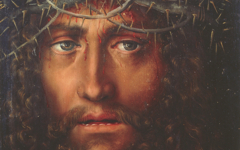Cranach’s Animals in Adam and Eve’s (1509-1533)
Lucas Cranach and his studio painted many versions of Adam and Eve, the later ones with a variety of animals. The only animal playing a principal role in the Bible's description of the Garden of Eden is the nefarious serpent but in Cranach's Gardens, near the limbs of Man's first couple, other animals appear. Gabriel Dette asserts that lion and deer, living together amicably, are features of paradise and "well-known symbols of Christ."1 The lion here, though, conveys none of Christ's love and kindness towards human beings.2 Besides, The Dictionary on Sacred Languages notes that a lion is as likely to symbolize the devil as Christ.
Click next thumbnail to continue
Right next to the lion's head, though, is Cranach's monogram, a flying serpent, and the date,1533, inscribed in gold on the tree (left). The combination of the lion's gaze outwards and the artist's monogram strongly suggests an identification, first and foremost, with Cranach himself. This is even more likely given the exaggerated size and prominence of the lion's only visible paw, a clear allusion to the artist's hand given its proximity to the artist's monogram.
Click next thumbnail to continue
In a slightly earlier version of the subject, in which Adam and Eve are on separate panels, a stag is now in the lion's position close to Eve's legs.
Click next thumbnail to continue

Left: Detail of Cranach's Eve (1530)
Right: Cranach the Elder's Self-portrait or Portrait of Lucas Cranach the Elder by Lucas Cranach the Younger (1550's)
Click image to enlarge.
Here there can be even less doubt that the stag is an animal alter ego of the artist given the similarity of its mane to Cranach's beard. Although the portrait at left is dated 20 years after the stag, there are likely to have been earlier portraits of Cranach with a similar beard now lost. One of the characteristics of self-portraits by great artists is that when multiple versions exist from different stages of life they often maintain a similar view of the head in a variety of versions.3
Click next thumbnail to continue

Left: Detail of Hogarth's Self-portrait in William Hogarth painting the Comic Muse (1758)
Right: Detail of Cranach's Eve (1530)
Click image to enlarge.
Not only does the stag's beard resemble the artist's but a raised leg also suggests the bent and extended arm of a painter painting. The comparison at left with an image in profile of Hogarth painting helps illustrate the visual metamorphosis behind a painter transformed into a stag. The stag is, moreover, like the later lion, in the lower right-hand corner of the composition where signatures traditionally go.
See conclusion below
Cranach's full-length figures are sometimes criticized for a lack of convincing illusion, a still-medieval understanding of anatomy and a failure to stand solidly on the ground. Dette remarks that the Adam and Eve in this example, based on a notion of ideal beauty, "are restricted to the foreground" and seem to "hover" over the background.4 Now that the lion and stag have been identified as self-representations of the artist, the nude figures of Adam and Eve can be seen for what they are: a mental image of a flat painting on panel floating in the dark of the artist's mind. That is why Cranach's figures look medieval and not real. They are meant to look like what people of the time associated with paintings. They are not and were never intended to be part of the landscape.
I should point out, though it is not the focus of this entry, that Adam closely resembles Cranach's earlier self-portraits so, in putting his arm around a white-washed Eve, he indicates that Eve is "his work of art" just as he, the artist, is a painting too. Together they are an archetypal image of the artist's androgynous mind in which the art is an image of the artist and his art.
More Works by
Notes:
1. Cranach (London: Royal Academy of Arts) 2008, p.364, cat.# 118
2. G. A. Gaskell, Dictionary of the Sacred Languages of All Scriptures and Myths, v.2 (London: George Allen and Unwin) 1923, p.454 reprinted by Kessenger Legacy Reprints, 2003.
3. This portrait of Cranach was long thought to be a self-portrait. Some recent scholars now think that it might be a portrait of the elder Cranach by the younger one, also a painter. Nevertheless, it maintains almost precisely the same view of the head, flipped horizontally, as the artist's known self-portrait in the 1554 Weimar Altarpiece.
4. Cranach, op. cit., p. 364
Original Publication Date on EPPH: 08 Aug 2012. | Updated: 0. © Simon Abrahams. Articles on this site are the copyright of Simon Abrahams. To use copyrighted material in print or other media for purposes beyond 'fair use', you must obtain permission from the copyright owner. Websites may link to this page without permission (please do) but may not reproduce the material on their own site without crediting Simon Abrahams and EPPH.




